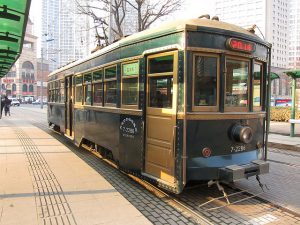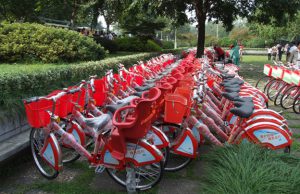Cars are the lifeblood of the American city. Even in the most successful walking and transit cities, they are everywhere, contributing activity and vitality to the streetscape.
Sadly, however, the automobile has been given free rein to distort American cities and lives. Long gone are the days when automobiles expanded possibility and choice for the majority of Americans. Now, thanks to its ever-increasing demands for space, speed, and time, the car has reshaped American landscape and lifestyles around its own needs. It is an instrument of freedom that has enslaved us.
This outcome is not an accident. No other nation has produced anything remotely like the National Interstate and Defense Highways Act of 1956 and, not coincidentally, none has been held in thrall by a lobby as powerful as our “Road Gang,” the consortium of “oil, cement, rubber, automobile, insurance, trucking, chemical, and construction industries, consumer and political groups, financial institutions, and media” that, along with the military, pushed successfully for new highways.
Whether or not it was good for America, the federal Highway Act and its subsequent iterations began at midcentury to distinguish American cities dramatically from their counterparts in other countries.
Highways vs. cities
The most interesting article on this topic is a little-known academic paper by Patrick Condon from the University of British Columbia. Entitled “Canadian and American Cities: Our Differences Are the Same,” this study clearly shows a compelling inverse correlation between highway investment and urban property values.
The researchers expected to find a broad range of historical and cultural causes behind the differing fates of Canadian and US cities. Instead, they found that these cities appeared almost identical in 1940, and then tracked in different directions based upon relative highway investment. It didn’t matter whether a city was American or Canadian: The highway-investment history was all you needed to know to accurately predict the real-estate-value history.
The bottom line was as follows: the more a city invested in highways, the more worthless its downtown became. Pauses in highway investment brought with them pauses in real-estate decline. Then, as new roads were built and old roads were widened, inner-city deterioration kicked back in with renewed vigour.
The sad thing is, we knew better. Even Lewis Mumford, a fan of decentralisation, admitted that “The right to have access to every building in the city by private motorcar, in an age when everyone possesses such a vehicle, is actually the right to destroy the city.”
The walkability dividend
The American city that perhaps epitomizes the benefits of trading automobility for walkability is Portland, Oregon. What makes Portland unusual is how it has chosen to grow. While most American cities were building more highways, Portland invested in transit and biking. While most cities were reaming out their roadways to speed traffic, Portland implemented a Skinny Streets program. While most American cities were amassing a spare tire of undifferentiated suburban sprawl, Portland instituted an urban growth boundary. These efforts and others like them, over several decades—a blink of the eye in planner time—have changed the way that Portlanders live.
This change is not dramatic—were it not for the roving hordes of bicyclists, it might be invisible—but it is significant. While almost every other American city has seen its residents drive farther and farther every year, and spend more and more of their time stuck in traffic, Portland’s vehicle miles traveled per person peaked in 1996. Now, compared to other major metropolitan areas, Portlanders on average drive 20% less.
Small change? Not really. This 20% adds up to 4 miles and 11 minutes per citizen per day. The economist Joe Cortright determined that these two factors add up to 3.5% of all personal income earned in the region.
What happens to these savings? While some goes into increased recreation, most of it ends up being spent in and on the Portlanders’ homes. And while almost 85% of money expended on driving leaves the local economy, housing is about as local an investment as you can get.
But the real Portland story is neither its transportation savings nor its housing investment, but something else: young, smart people are moving to Portland in droves. According to Cortright and co-author Carol Coletta:
“Over the decade of the 1990s, the number of college-educated 25 to 34 year-olds increased 50% in the Portland metropolitan area—five times faster than in the nation as a whole, with the fastest increase in this age group being recorded in the city’s close-in neighborhoods.”
There is another kind of walkability dividend, aside from resources saved and resources reinvested: resources attracted by being a place where people want to live. This message is not lost on most American cities, who are keenly aware that they are competing for highly mobile entrepreneurial talent.
That’s the good news. Unfortunately, most US cities are not yet like Portland. Since the 1970s, the number of roads in America has roughly doubled, which has led to a corresponding increase in the amount of money that the average American spends on transportation, from 10% to 20% of all income earned. Remarkably, the typical poor American family spends 40 percent of its income on transportation—considerably more than on housing. And as US roads age and demand repair, governments at every level are finding that they cannot possibly foot the bill.
We Americans have learned that reorganising our cityscapes around the automobile was a bad investment, not to mention an environmental disaster. Like many European cities, our most forward-thinking municipalities have turned away from road investment in favor of transit, bicycling, and pedestrian infrastructure. The evidence seems to support a contention of Winston Churchill: “The American people can be counted on to do the right thing, after they have exhausted all the alternatives."







